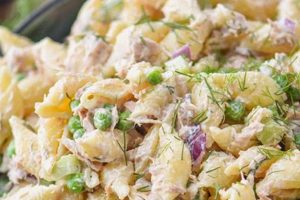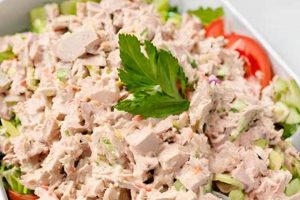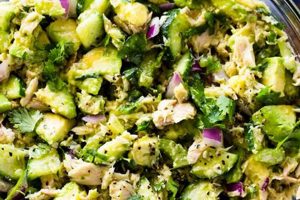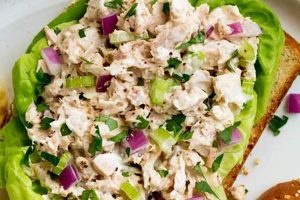A combination of canned tuna, mayonnaise, and other ingredients such as celery, onion, or relish, forms a filling encased within a soft tortilla or flatbread. Variations can include different types of tuna, additions like hard-boiled eggs or pickles, and a range of seasonings. A simple example might involve mixing flaked tuna with mayonnaise, chopped celery, and salt and pepper, then spreading this mixture onto a whole wheat tortilla before rolling it tightly.
This convenient and customizable meal offers a balance of protein and carbohydrates, making it a suitable option for a quick lunch, picnic, or light dinner. Its adaptability to different flavor profiles, from classic to spicy or tangy, contributes to its widespread popularity. Historically, readily available canned tuna and the increasing use of tortillas and wraps in various cuisines likely influenced the dish’s emergence as a common meal choice.
The following sections will delve into specific ingredient choices, step-by-step preparation instructions, tips for achieving optimal flavor and texture, and suggestions for creative variations.
Tips for Crafting Exceptional Tuna Salad Wraps
Optimizing a tuna salad wrap involves careful consideration of ingredient quality and preparation techniques. Attention to detail ensures a flavorful and satisfying culinary experience.
Tip 1: Use high-quality canned tuna. Opting for tuna packed in water or olive oil, rather than oil, contributes to a healthier and less greasy final product. Selecting solid or chunk light tuna offers a firmer texture compared to flaked.
Tip 2: Drain the tuna thoroughly. Excess liquid can result in a watery filling that compromises the wrap’s structural integrity. Pressing the tuna gently with a fork against the sides of the can or using a strainer helps remove excess moisture.
Tip 3: Enhance the mayonnaise. A simple addition of lemon juice, Dijon mustard, or a pinch of cayenne pepper elevates the flavor profile of the mayonnaise base. Greek yogurt can be incorporated for a lighter, tangier twist.
Tip 4: Add textural complexity. Finely diced celery, red onion, or water chestnuts provide a satisfying crunch. Chopped grapes or apples introduce a touch of sweetness and contrasting texture.
Tip 5: Season thoughtfully. Freshly ground black pepper, garlic powder, or a dash of paprika enhance the overall flavor. Herbs like dill or parsley add freshness.
Tip 6: Choose the right wrap. Whole wheat tortillas offer a nutritious and sturdy base. Larger wraps accommodate more filling, while smaller ones provide portion control. Spinach or herb-infused wraps add flavor and visual appeal.
Tip 7: Chill before serving (optional). Allowing the assembled wraps to chill in the refrigerator for a short period firms the filling and allows the flavors to meld.
By following these guidelines, one can create a tuna salad wrap that is both delicious and satisfying. Attention to these details ensures a flavorful, texturally balanced, and visually appealing meal.
The following section will provide a complete recipe incorporating these tips, along with suggestions for variations and serving recommendations.
1. High-quality Canned Tuna
High-quality canned tuna plays a pivotal role in the overall success of a tuna salad wrap recipe. Tuna quality directly impacts flavor, texture, and nutritional value. Opting for premium tuna, typically packed in olive oil or water, yields a noticeably superior result compared to using lower-grade options. For instance, albacore tuna offers a delicate flavor and firm texture, enriching the wrap’s sensory experience. Conversely, less expensive skipjack or yellowfin tuna might possess a stronger, fishier taste and a softer, sometimes mushy consistency, potentially detracting from the final product.
The impact extends beyond taste and texture. Higher-quality canned tuna often contains lower levels of mercury, an important consideration for health-conscious consumers. Additionally, the packing liquid itself contributes to the overall flavor profile. Olive oil-packed tuna imparts a richness, while water-packed tuna offers a cleaner taste, allowing other ingredients to shine. This distinction allows for greater control over the final flavor profile of the tuna salad, tailoring it to individual preferences or dietary restrictions. Utilizing tuna packed in oil may necessitate less added mayonnaise, contributing to a lighter overall calorie count.
Ultimately, the choice of canned tuna significantly influences the overall quality of the tuna salad wrap. Investing in higher-quality tuna ensures a more palatable and nutritionally sound meal. This careful selection enhances flavor, texture, and overall satisfaction, demonstrating that superior ingredients translate directly to a superior final product. Discerning palates will undoubtedly appreciate the difference, and the nutritional benefits further solidify the importance of this ingredient selection.
2. Flavorful Mayonnaise Base
The mayonnaise base serves as the foundation of flavor and texture in a tuna salad wrap recipe. Its quality and composition significantly influence the overall culinary experience. A well-crafted mayonnaise base elevates the other ingredients, binding them together harmoniously and contributing to a cohesive, satisfying final product. Conversely, a bland or poorly executed base can detract from even the highest-quality tuna or freshest vegetables.
- Mayonnaise Quality
Utilizing high-quality mayonnaise forms a critical starting point. Ingredients, processing methods, and fat content all contribute to mayonnaise flavor profiles and textures. For instance, mayonnaise made with real eggs and extra virgin olive oil offers a richer, creamier texture and a more nuanced flavor compared to mayonnaise made with egg substitutes or other oils. This choice impacts not only the taste of the filling but also the mouthfeel of the entire wrap.
- Flavor Enhancements
Flavorful additions to the mayonnaise significantly elevate the overall taste profile. Classic additions like lemon juice or Dijon mustard provide brightness and tang, cutting through the richness of the mayonnaise and tuna. Finely chopped fresh herbs such as dill, chives, or parsley introduce a fresh, herbaceous element. Spices like paprika, cayenne pepper, or garlic powder contribute depth and complexity. Each addition plays a distinct role, and the balance of these flavors creates a dynamic and engaging culinary experience. The choice of enhancements should complement the other ingredients in the wrap, creating a harmonious balance.
- Texture Considerations
Texture plays a crucial role in the overall enjoyment of the tuna salad wrap. The mayonnaise base contributes significantly to this element. A thick, creamy mayonnaise base creates a luxurious mouthfeel, while a thinner consistency may result in a less satisfying experience. The inclusion of finely diced ingredients within the mayonnaise base itself, such as pickles or capers, can further enhance textural complexity. Careful consideration of texture ensures a balanced and enjoyable wrap.
- Balance and Proportion
Achieving a balanced flavor profile requires careful consideration of ingredient proportions within the mayonnaise base. Too much mayonnaise can overpower the other ingredients, resulting in a bland and overly rich filling. Too little may not adequately bind the ingredients together, leading to a dry and crumbly texture. Finding the optimal ratio of mayonnaise to other flavoring agents ensures a cohesive and satisfying final product. A balanced base allows the distinct flavors of the tuna, vegetables, and seasonings to shine through without being masked by an excessive amount of mayonnaise.
By carefully considering these facets of the mayonnaise base, one can elevate a simple tuna salad wrap from ordinary to extraordinary. The mayonnaise base is not merely a binding agent; it is a canvas upon which to create a symphony of flavors and textures, ultimately enhancing the enjoyment of this classic dish. The interplay of quality ingredients, complementary flavors, appropriate texture, and balanced proportions transforms the mayonnaise base into the defining element of a truly exceptional tuna salad wrap.
3. Crunchy Textural Elements
Crunchy textural elements play a vital role in enhancing the sensory experience of a tuna salad wrap recipe. A predominantly soft or mushy texture can lead to a less satisfying meal. Incorporating ingredients that provide a contrasting crispness or crunch elevates the overall enjoyment. This textural contrast creates a more dynamic and engaging eating experience. The interplay of soft and crunchy elements stimulates the palate, making each bite more interesting and preventing the wrap from feeling monotonous.
Several ingredients can contribute the desired crunch. Common choices include finely diced celery, red onion, water chestnuts, or chopped bell peppers. These vegetables offer varying degrees of crispness and subtly different flavor profiles, allowing for customization based on individual preferences. Less conventional options, such as chopped walnuts, pecans, or sunflower seeds, introduce both crunch and a nutty flavor dimension. Even crumbled crispy bacon or fried onions can be incorporated for a more savory crunch. The choice of crunchy elements should complement the other flavors in the wrap, creating a harmonious balance. For example, the slight bitterness of celery complements the richness of the tuna and mayonnaise, while the sharp bite of red onion adds a piquant contrast.
The practical significance of incorporating crunchy textural elements extends beyond mere sensory enjoyment. The addition of these ingredients can also contribute to the structural integrity of the wrap. Finely diced vegetables or nuts help to absorb excess moisture from the tuna and mayonnaise, preventing the wrap from becoming soggy and difficult to handle. This is particularly important for wraps that are prepared in advance and transported, such as for picnics or packed lunches. The crunchy elements maintain a desirable texture even after some time has elapsed, ensuring a consistently satisfying eating experience. Furthermore, the increased textural complexity often leads to greater perceived satiety, contributing to a more fulfilling meal.
4. Complementary Seasonings
Complementary seasonings represent a critical factor in elevating a tuna salad wrap recipe from simple to exceptional. Seasoning choices directly influence the overall flavor profile, balancing the richness of the tuna and mayonnaise with nuanced complexity. Thoughtful seasoning selection transforms the flavor profile, creating depth and enhancing the other ingredients. A bland tuna salad, even with high-quality ingredients, can become a truly satisfying culinary experience through the judicious application of spices and herbs. For example, freshly ground black pepper adds a subtle heat and enhances the inherent flavors of the tuna. A pinch of cayenne pepper introduces a more pronounced spiciness, while paprika contributes a smoky depth. Garlic powder or onion powder provide savory notes, while dried dill or parsley offer a fresh, herbaceous counterpoint.
The impact of complementary seasonings extends beyond enhancing existing flavors. Strategic seasoning choices can also brighten the overall flavor profile, cutting through the richness of the mayonnaise and preventing the wrap from feeling heavy. A squeeze of fresh lemon juice adds a vibrant acidity, while a dash of Dijon mustard provides a tangy complexity. These brighter notes balance the richness of the other ingredients, creating a more harmonious and refreshing flavor experience. The interplay of these flavors transforms the tuna salad from a simple combination of ingredients into a multi-dimensional culinary creation. Furthermore, the choice of seasonings can be tailored to complement other ingredients within the wrap, such as the addition of curry powder to complement a wrap containing chopped apples and raisins.
Mastery of complementary seasonings involves not only selecting the right spices and herbs but also understanding their proper application. Over-seasoning can easily overpower the delicate flavor of the tuna, while under-seasoning results in a bland and uninspired final product. The key lies in achieving a balance that enhances the existing flavors without masking them. Freshly ground spices generally offer a more potent flavor than pre-ground versions, allowing for greater control over the intensity. Adding seasonings in stages, tasting and adjusting as needed, ensures the desired flavor profile is achieved. This iterative process, combined with an understanding of flavor pairings and balance, distinguishes a truly exceptional tuna salad wrap from a mediocre one. The careful consideration of complementary seasonings demonstrates a commitment to culinary excellence, transforming a simple lunch item into a flavorful and memorable dining experience.
5. Appropriate Wrap Selection
Appropriate wrap selection significantly influences the overall success of a tuna salad wrap recipe. The wrap serves as more than just a vessel for the filling; it contributes to the structural integrity, textural complexity, and overall sensory experience. The interplay between the wrap and the filling necessitates careful consideration of several factors, including flavor compatibility, size, and structural integrity. Selecting a wrap that complements the tuna salad filling, rather than competing with it or detracting from its enjoyment, is paramount. For example, a whole wheat tortilla offers a subtly nutty flavor that complements the savory tuna salad, while a spinach or herb-infused tortilla can add another dimension of flavor complexity. Conversely, a strongly flavored wrap, such as a sundried tomato or jalapeo cheddar, might overpower the delicate flavor of the tuna salad.
Practical considerations also influence wrap selection. The size of the wrap dictates the amount of filling it can accommodate. Overfilling a small wrap can lead to structural failure and a messy eating experience, while underfilling a large wrap can result in a dry and unsatisfying meal. Wrap thickness also plays a role. A thin wrap might tear easily under the weight of the filling, especially if the filling is moist. A thicker wrap offers greater durability and can better withstand the moisture content of the tuna salad. Furthermore, the pliability of the wrap affects its ease of rolling and handling. A stiff wrap might crack or break during rolling, while a highly pliable wrap might be difficult to handle and prone to tearing. Choosing a wrap with the appropriate balance of pliability and structural integrity ensures a successful and enjoyable eating experience. For instance, a large, sturdy whole wheat tortilla is well-suited for a generous portion of tuna salad, while a smaller, thinner spinach tortilla might be better suited for a lighter filling or a smaller appetite.
In conclusion, appropriate wrap selection represents a crucial element in crafting a successful tuna salad wrap. Flavor compatibility, size, thickness, and pliability all contribute to the overall experience. Careful consideration of these factors ensures a structurally sound, texturally satisfying, and flavorfully balanced final product. The wrap should complement and enhance the tuna salad, not detract from it. A well-chosen wrap elevates the simple tuna salad wrap from a basic lunch item to a satisfying and enjoyable culinary creation. Ignoring the importance of wrap selection can compromise the entire meal, highlighting the practical significance of this seemingly minor detail.
6. Proper Ingredient Proportions
Proper ingredient proportions constitute a critical factor in determining the success of a tuna salad wrap recipe. A balanced ratio of ingredients contributes significantly to the overall flavor profile, textural integrity, and ease of assembly. Disproportions can lead to a variety of undesirable outcomes, ranging from a bland and watery filling to an overly rich and unwieldy wrap. The delicate interplay between the core componentstuna, mayonnaise, and textural elementsrequires careful calibration to achieve the desired result. For instance, an excess of mayonnaise can overpower the flavor of the tuna and compromise the structural integrity of the wrap, resulting in a soggy and difficult-to-handle product. Conversely, insufficient mayonnaise can lead to a dry, crumbly filling that lacks cohesion and flavor.
Consider the impact of ingredient proportions on textural elements. A properly balanced tuna salad incorporates crunchy vegetables like celery or red onion to provide textural contrast to the softness of the tuna and mayonnaise. However, an overabundance of these crunchy elements can make the wrap difficult to bite and chew, while too few can result in a monotonous, mushy texture. The proportion of these elements relative to the tuna and mayonnaise directly impacts the overall eating experience. Similarly, the quantity of seasonings plays a crucial role. Over-seasoning can mask the delicate flavor of the tuna, while under-seasoning can produce a bland and unappetizing filling. Achieving the correct balance of seasonings enhances the natural flavors of the ingredients without overpowering them. Specific measurements, while helpful as a starting point, should be adapted based on individual preferences and the specific ingredients used. For example, using a particularly flavorful tuna might necessitate less added seasoning, while a milder tuna might require more.
Understanding the importance of proper ingredient proportions empowers one to create a tuna salad wrap that is not only flavorful and texturally appealing but also structurally sound and easy to assemble. A well-proportioned tuna salad holds its shape within the wrap, preventing leakage and facilitating easy handling and consumption. This balance ensures a satisfying and enjoyable eating experience, demonstrating the practical significance of this often-overlooked aspect of recipe development. Mastery of ingredient proportions distinguishes a truly exceptional tuna salad wrap from a mediocre one, highlighting the importance of precision and balance in culinary endeavors.
7. Efficient Assembly Techniques
Efficient assembly techniques are integral to a successful tuna salad wrap recipe, impacting both the structural integrity and aesthetic appeal of the final product. Methodical preparation and attention to detail ensure a well-constructed, visually appealing wrap that is easy to handle and consume. A haphazard approach can result in a messy, structurally unsound wrap with uneven filling distribution, detracting from the overall dining experience. The connection between efficient assembly and the final product’s quality is undeniable. For example, evenly spreading the tuna salad across the tortilla prevents leakage and ensures each bite contains a balanced proportion of filling. Proper rolling techniques create a tight, compact wrap that holds its shape, while securing the wrap with toothpicks or parchment paper further enhances its structural integrity, especially for transport or storage.
Several key techniques contribute to efficient assembly. First, proper preparation of the ingredients, including thorough draining of the tuna and consistent chopping of vegetables, establishes a foundation for success. Next, even distribution of the tuna salad across the center of the wrap ensures a balanced flavor profile in each bite and prevents structural imbalances that can lead to tearing or leakage. The rolling technique itself requires a delicate balance of firmness and gentleness. Rolling too tightly can cause the wrap to burst, while rolling too loosely results in a floppy, unwieldy product. Starting with a tight initial fold and maintaining consistent pressure throughout the rolling process yields a secure, well-formed wrap. Finally, securing the wrap with toothpicks or wrapping it in parchment paper provides additional structural support, particularly beneficial when preparing wraps in advance for travel or storage. These techniques contribute to a polished, professional presentation, enhancing the overall appeal of the dish.
Ultimately, efficient assembly techniques are essential for maximizing the enjoyment and convenience of a tuna salad wrap. A well-constructed wrap is not only visually appealing but also easy to handle and consume, preventing messy spills and enhancing portability. These techniques, while seemingly minor, contribute significantly to the overall dining experience, demonstrating the importance of attention to detail in even the simplest of culinary endeavors. Mastering these techniques elevates the tuna salad wrap from a basic lunch item to a carefully crafted culinary creation, highlighting the impact of efficient execution on the final product. This understanding underscores the interconnectedness of technique and outcome, a crucial principle applicable to a wide range of culinary pursuits.
Frequently Asked Questions
This section addresses common inquiries regarding tuna salad wrap preparation, offering concise and informative responses.
Question 1: What type of tuna is best suited for tuna salad wraps?
While various canned tuna options suffice, albacore tuna, packed in either water or olive oil, generally yields a superior flavor and texture compared to chunk light tuna. Consideration of sodium content and personal preferences may influence this selection.
Question 2: How can excess moisture in the tuna salad be avoided?
Thoroughly draining the canned tuna is crucial. Pressing the tuna against the can’s sides with a fork or utilizing a strainer effectively removes excess liquid, preventing a watery filling.
Question 3: What alternatives exist for those who dislike mayonnaise?
Plain Greek yogurt, mashed avocado, or a combination of olive oil and lemon juice offer suitable alternatives to mayonnaise, contributing moisture and flavor without the richness of mayonnaise.
Question 4: How can the nutritional value of a tuna salad wrap be enhanced?
Incorporating whole wheat tortillas, adding nutrient-rich vegetables like chopped spinach or shredded carrots, and opting for lean protein sources like tuna packed in water contribute to a more nutritious meal.
Question 5: How can tuna salad wraps be stored effectively?
Wrapping individual portions tightly in plastic wrap or aluminum foil allows for convenient refrigeration for up to three days. Maintaining a cool temperature preserves freshness and prevents bacterial growth.
Question 6: Can tuna salad wraps be frozen?
While freezing is possible, the texture of the ingredients, particularly the vegetables, may be compromised upon thawing. Fresh consumption is generally recommended for optimal quality and flavor.
Addressing these common questions provides a foundation for successful tuna salad wrap preparation. Understanding the nuances of ingredient selection, preparation techniques, and storage practices contributes to a more enjoyable and satisfying culinary experience.
The following section provides additional tips and variations for customizing the classic tuna salad wrap recipe.
Tuna Salad Wrap Recipe
Preparation of a tuna salad wrap, while seemingly straightforward, benefits from careful consideration of several key elements. Ingredient selection, from the quality of canned tuna to the choice of wrap, significantly impacts the final product. Proper proportions and thoughtful seasoning elevate the flavor profile, while efficient assembly techniques ensure both structural integrity and aesthetic appeal. Understanding these nuances transforms a simple lunch item into a carefully crafted culinary creation. From optimizing the mayonnaise base to incorporating crunchy textural elements, attention to detail yields a more satisfying and enjoyable dining experience. Addressing common preparation challenges, such as managing excess moisture and ensuring proper storage, further contributes to consistent results.
Culinary exploration extends beyond mere sustenance; it represents an opportunity for creativity and personal expression. The tuna salad wrap, with its inherent adaptability, provides a canvas for culinary innovation. Experimentation with diverse ingredients, flavor combinations, and presentation styles unlocks the potential for personalized variations. This ongoing exploration enriches culinary experiences, fostering an appreciation for the art of food preparation and its capacity to nourish both body and mind. The potential for continued refinement and adaptation ensures the enduring relevance of this versatile and satisfying dish.






